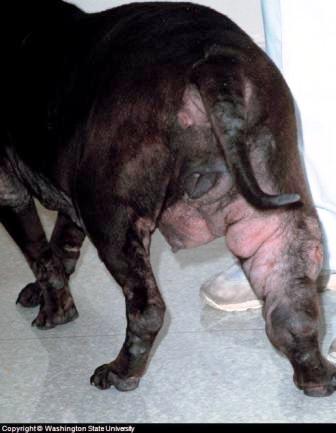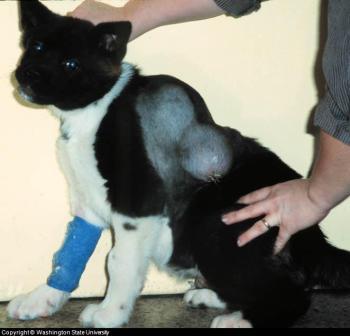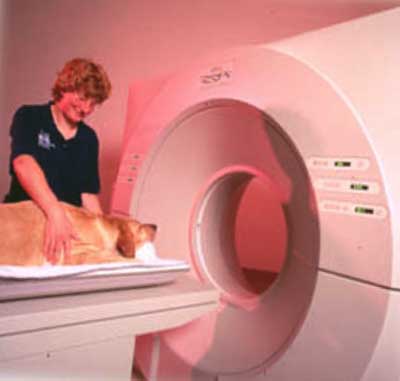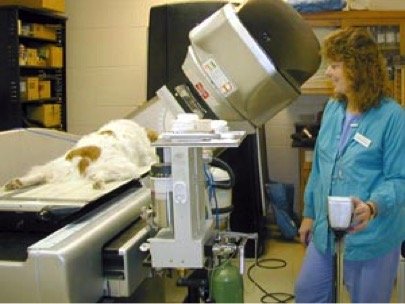Table of Contents
Overview | Types | Breeds | Symptoms | Diagnosis | Treatment | Diet | Podcast | Q&A
Summary:
"Canine cancer is the result of cell growth which is uncontrolled and that serves no purpose. Cancer in dogs is also referred to as a neoplasia, tumor and malignancy. Any body tissue can develop cancer.
Cancer either originates at a site, which is called primary cancer or spreads from another area, which is called secondary cancer. Cancer spreads in the body through the blood or the lymph system, with lymphomas being one of the most common cancers in dogs. Estimates indicate that 24% of canine cancer is caused by lymphoma. The disease is found in dogs as young as 3 years old. The FDA has approved Tanovea (rabacfosadine Injection) to treat lymphoma in dogs.
Another type of common cancer in dogs is called hemangiosarcoma, which is cancer of the blood vessels. 30% of canine cancers are hemangiosarcoma. This type of cancer is prevalent in Golden Retrievers and German Shepherds with 20% of all dogs at a lifetime risk.
Once a cancer starts to spread it becomes increasingly more difficult to treat (called cancer that has metastasized). Treatment for specific types of cancer in dogs can be found by clicking on the links below for each specific type."
Overview
Hearing that your dog has canine cancer does not mean the end of its life. Like cancer treatment in people, there are now many options for treating your pet. In general, treatments tend to be more effective and have fewer side effects. Cancer is seen in about 1,100 of every 100,000 dogs and is treated by a veterinary oncologist.
Cancer is often referred to as a tumor, which is any sort of lump of bump. Tumors that grow are called neoplasms. There are two types of tumors:
- Benign:
Tumors that grow slowly and don’t spread to other parts of the body are
considered benign as they have not metastasized or spread. A benign
tumor is treated with surgery.
- Malignant: These tumors are the same as cancer and are also called carcinomas, sarcomas and lymphomas depending on where the cancer is on the body. As the cancer spreads from one part of the body to another, it can enter the lymph nodes or circulatory system. The spread is called metastasizing.
Tips For Catching Cancer Early
Here are 5 tips for catching cancer in dogs early:
- Every week feel over your dogs skin for bumps and lumps.
- Inspect the mouth for anything unusual or that has changed.
- Check skin for changes such as:
- color
- swelling
- blood
- lumps
- anything that appears suspicious - Track anything that you find in writing. Note the size, date and time. Take a picture if you can.
- Watch your dogs for signs such as:
- behavioral change
- appetite loss
- changes in activity or interest in activities
Types of Canine Cancer and Tumors
- Dog Neoplasia Overview
- Anal Gland Tumors
- Bladder Cancer
- Breast Cancer
- Bone Cancer
- Benign Bone Tumors
- Chondrosarcoma
- Hemangiosarcoma
- Intestinal Cancer
- Kidney Cancer
- Leukemia
- Alternative Treatment Options - Leukemia and Other Cancers
- Liver Tumors
- Lumps and Bumps on Skin
- Lymphoma
- Lymphosarcoma
- Mammary Cancer
- Multiple Myeloma
- Osteosarcoma
- Prostate Cancer
- Prostate Cancer in Dogs
- Skin Cancer
- Spleen Cancer
- Stomach Cancer
- Thyroid Cancer
What is Canine Cancer?
In a normal dog cells are constantly dying and being replaced. In a dog with cancer, something is wrong with the replacement cells (called mutant cells). These mutant cells reproduce quickly and form into large groupings. Since these cells are mutant, they cannot provide the same function as the healthy cells they replaced. If these cells or cancer grows, it eventually replaces healthy tissue and causes the dog to die.
Tumors on Dog Leg

High Risk Breeds and Types of Cancer
- Airdale Terrier* - Lymphoma risk
- Basset Hound – Trichoepithelioma and Lymphoma
- Bernese Mountain Dog* - greatest incidence of cancer in a 20-year study of nearly 75,000 dogs
- Boxer and Pug – Mast Cell Tumor
- Bouvier des Flandres*
- Boxer*- Lymphoma risk
- Bulldogs - Lymphoma risk
- Bullmastiff* - lymphoma risk
- Cocker Spaniel – Ceruminous Adenoma and Cutaneous Plasmacytoma
- English Cocker Spaniel – Anal sac gland carcinoma
- German Shepherd - high risk for hemangiosarcoma
- Giant Schnauzer and Gordon Settler – Subungual squamous cell carcinoma
- Golden Retriever* - high risk for hemangiosarcoma and lymphoma
- Kerry Blue Terrier – Pilomaticoma
-
Vizsla and Miniature Schnauzer – melanocytoma
- Saint Bernards - lymphoma risk
- Scottish Terrier* – Subungual malignant melanoma and Lymphoma
- Shetland Sheepdog – liposarcoma
- Irish Setter*
- Gordon Setter*
*According to a study in the Journal of Veterinary Internal Medicine that reviewed causes of death for nearly 75,000 dogs from 1984 to 2004, breeds where cancer is more common.
Symptoms
There are several early warning signs of dog cancer symptoms:
- Unusual swelling that continues to grow
- Sores that do not heal
- Weight Loss
- Loss of appetite
- Offensive odor, especially from the mouth
- Bleeding or discharge from any body opening
- Reluctance to move or exercise, loss of stamina
- Difficulty eating or swallowing
- Loss of energy
- Difficulty breathing, urinating or making a bowel movement
- Sleeping more than usual
- Persistent lameness or stiffness
Dog Cancer Symptoms Example

Symptoms Requiring Emergency Treatment
-
Your dog has collapsed
- Bleeding after receiving chemotherapy
- Loss of appetite while undergoing treatment
Symptoms Requiring a Call or Visit to Your Veterinarian
- Skin – Sores, bumps, lumps
- Leg – Large breed with swelling or a limp
- Seizure - In older dog that has a
seizure (uncontrolled shaking) for the first time
- Nose – blood coming from the nose
- Mouth – Lump, bump or growth
- Breast – lump or swelling
For more information visit our guide to cancer symptoms.
Diagnosis
Determining if your dog has cancer usually requires more than blood tests or x-rays. Your Veterinarian will need to take a sample of the area in question (a biopsy) and send it to a laboratory to test for the presence of cancer. Cancer cannot be diagnosed visually since an examination of individual cells is necessary. If cancer cells are found (called malignant), your entire dog will need to be examined since many types of cancer can spread.
Testing will help the veterinarian classify the stage of development the tumor is in. Each stage is associated with a specific treatment protocol or plan and indicates a dog's prognosis (course and outcome of the disease).
Dog Cancer Diagnostic MRI

Tests for Canine Cancer
Even with the advanced canine cancer tests listed below, it is still possible to miss a small tumor.
- Biopsy – The removal of a small sample
(non-excisional) or an attempt to completely remove a cancerous mass
(excisional). The biopsy is sent
to a lab for analysis. A veterinarian may remove an entire lymph node
to see if cancer has spread or if cancer of the lymph nodes exists.
- Fine-needle Aspiration (FNA) – Like a
biopsy, but instead of surgery, a needle is used to extract cancerous
cells for testing.
- Blood Tests (CBC) – Changes in the composition of blood could indicate problems such as low red blood cells, high white blood cells or changes in kidney and liver function. These test are called a chemistry profile and blood count. There are recent advances in cancer treatment and diagnostics based on genetics. One approach is called "liquid biopsy." In this approach the blood is analyzed for DNA mutations that are associated with cancers. The test shows if cancer is present, if your dog has gone into remission or if a relapse has occurred. The FDA has approved liquid biopsies for human cancers, but some of the same human DNA mutations are found in canine cancer.
- X-Ray – An x-ray will detect tumors in
the lungs, chest or bones.
- Ultrasound – The best technique for
detecting tumors in the abdomen. A biopsy would be needed to confirm
any findings.
- Endoscopy – A video camera on a thin
tube that is inserted into the mouth or nose to look for tumors. Used
to examine the colon, bronchi and stomach.
- Surgery – To examine any area in
question.
- CT/MRI Scans – Best technique for
detecting tumors that are near bone are unable to be seen by
X-rays.
- Urinalysis- To check urine components
- Bone Marrow Aspirate - The removal and testing of bone
marrow
- Lymph Node Aspirate - The removal of lymph node
fluid
- Immunologic Studies - Testing immune response
Tumor Node Metastasis Rating System
A veterinary oncologist will use a ratings system that defines the size and spread of a tumor.
Tumor Size or Extent (T=Tumor):
- Tis: preinvasive tumor (in situ)
- T0: no evidence of tumor
- T1: tumor <5 cm in diameter but confined to primary site
- T2: tumor >5 cm in diameter or ruptured tumor
- T3: infiltrative tumor
a: no bone invasion
b: bone invasion
N = nodes:
- N0: no evidence of lymph node enlargement
- N1: movable ipsilateral nodes enlarged
- N2: movable contralateral/bilateral nodes enlarged
- N3: fixed nodes
M = metastasis:
- M0: no metastasis
- M1: metastasis detected
Treatment
If a tumor has spread (metastasized) in most cases a cure is
not possible, however with advances in veterinary cancer research veterinarian's have more treatment options than ever before. If a tumor is not treatable, the treatment focus is on maintaining a dog's quality of life
(this is called palliation). Palliation or palliative care seeks to
minimize pain and reduce any functional difficulties such as urination
and swallowing.
Tumors that have not spread (referred to as being localized) have the best prospects for being cured. Treatment usually involves some combination or single use of immunotherapy (improving the immune system), surgery, chemotherapy or radiation. Curative approaches are commonly used if the tumor can be controlled for one year or longer after the start of treatment.
For example, radiation can be used to shrink a tumor followed by surgical removal of any remaining cells.

Treatment Approaches for Canine Cancer:
Surgery
Cancers commonly treated with surgery include:
- Mammary tumors (except inflammatory mammary cancer) - most
prevalent tumor in female dogs.
- Prostate tumors
- Oropharyngeal tumors
- Skin cancers
- GI tumors
- Lung tumors
- Bone tumors
Surgery can have complications with risk increasing based on the age of the dog. Complications include incomplete healing, blood loss, wound infection and the formation of abscesses. There is also a risk of death caused by the surgery itself.
Radiation
Radiation therapy is used for many types of tumors. Cancers treated with radiation include:
- Brain tumors
- Small pituitary tumors (can be curative)
- To extend the survival time for spinal lymphomas and intracranial tumors
- Nasal cavity tumors
- Mast cell tumors
- Soft tissue sarcomas
- Thyroid tumors
Downsides include the possibility that the radiation will not reach cells in the center of the tumor. The radiation may effect surrounding skin or the lining of the gastrointestinal tract. Can also cause blindness or organ malfunction.
Chemotherapy
Chemotherapy is used to treat systemic cancers as the sole agent (see list that follows). It is also given to patients that have successfully completed surgery and/or radiation as an additional therapy. Chemotherapy can improve the effectiveness of radiation therapy while helping to slow down tumor growth.
When used in combination with surgery, chemotherapy can reduce tumor size before surgery. Other benefits include the ability to kill microscopic cells and to slow down tumor growth.
Canine cancers treated with chemotherapy include:
- hematologic malignancies
- metastatic carcinomas
- Metastatic sarcomas
Problems with chemotherapy include toxicity, problems with the immune system and anemia. Symptoms can include vomiting, nausea, problems with wound healing and dog hair loss.
Hyperthermia
Hyperthermia is considered to be the most effective treatment approach when used in combination with chemotherapy or radiation. It is used to treat tumors that are small (<1.0 cm) or malignant and superficial.
The limitations of hyperthermia canine cancer therapy includes that it can damage both normal and cancerous cells. It can also cause skin burns. Like other treatment methods, hyperthermia can be used in combination with radiation and chemotherapy.
With radiation, hyperthermia can double the response to therapy. It can improve survival teams by improving the rate of response to therapy. With chemotherapy the hyperthermia improves that performance of medications that work better at higher body temperatures. It may also protect normal cells against the toxicity of the chemotherapy agents. That said, other studies indicate that the combination of hyperthermia and chemotherapy might increase treatment toxicity.
Photodynamic Therapy (PDT)
PDT Canine Cancer Therapy

Photodynamic therapy for canine cancer is used in a limited number of instances. It is primarily used in dogs that have local (limited to one area) and superficial tumors that are minimally invasive. This includes tumors that are on the lining of the urinary bladder, oral cavity and skin.
Limitations of this type of therapy includes the inability of light to
deeply penetrate into the skin or tumor tissue. The dog patient must be
kept in reduced lighting conditions for 4 to 6 weeks after treatment.
Not all tumors react the same way to treatment.
Gene Therapy
There are four types of gene therapy available to treat dogs:
- Drug resistance gene therapy
- Tumor suppressor gene therapy
- Genetic immunotherapy
- Suicide gene therapy
Anti-Angiogenic Drugs
These medications work by cutting off the blood supply that "feeds" a tumor. These medications are in the early development stages.
Immunotherapy
Immunotherapy uses immune system processes to attack cancer cells.
Types of cancer treated include:
- Soft tissue sarcomas (includes hemangiosarcoma and fibrosarcoma)
- Osteosarcoma
- Mastocytoma
- Melanoma
- Lymphoma
There are several types of medications that alter the immune
response. This includes:
- Growth factors
- Antibody therapy
- Adoptive cellular therapy
- Monokines/Lymphokines
- Nonspecific immmunomodulators
Small Molecule Inhibitors
Small molecule inhibitors are used to treat various types of cancer as a standalone treatment or in combination with radiation or chemotherapy. These medications target specific cell functions that are associated with cancer mutation. One example is the drug toceranib phosphate (Palladia), which is approved for the treatment of mas cell tumors in dogs. Another is Laverdia Ca (Verdinexor) which if for treating dog lymphoma. Both of these drugs are oral treatments which are provided at home.
Alternative Therapies
There are several alternative therapies that can help to reduce pain and other symptoms such as nausea and vomiting. These include:
Acupuncture:
- for pain relief any vomiting and nausea that are side effects of chemotherapy and other treatment protocols
Massage:
- In cases where the massage will not interfere with treatment
Herbal Remedies:
- An oncologist might recommend products like C-Caps to
strengthen the patient or to address any side effects. If a dog is
undergoing chemotherapy or radiation, check with your veterinarian to
ensure that products like these can be used.
If a therapy is not available, then some dogs can be enrolled in a testing trial at a veterinary college. A list of universities that are conducting canine cancer trials can be found at the Veterinary Cancer Society.
Nutrition and Diet
In cancer patients, nutrition plays a dual role. It is most important to keep a patient healthy and nourished (to avoid a condition called cancer cachexia, which refers to severe malnutrition in cancer patients). Secondly, it is believed by some that some nutrients can help to slow down or prevent cancer. Other nutrients may be able to reduce the side effects of radiation and chemotherapy.
In general, a dog cancer diet includes an increase of protein and a decrease in carbohydrates (carbs or glucose might fuel cancer cells). Other nutrients such as some vegetables, fruits and supplements can have a positive effect.
The problem for dogs is when the cancer alters the metabolism. This
tends to happen during the early stages of cancer and will decrease the
dog's quality of life over the course of the disease.
See our guide to formulating canine cancer diets for details on all aspects of nutrition and canine cancer diets.
Dog Cancer Treatment Podcast
Here is a helpful podcast on cancer treatment in pets from the American Veterinary Medical Association. The podcast features Dr. Erika Krick, assistant professor of oncology at the University of Pennsylvania School of Veterinary Medicine. The discussion reviews recent development in canine cancer treatment.
AVMA Podcast
Hemangiosarcoma
Hemangiosarcoma accounts for 30% of all canine cancer cases. Approximately 1/5 of German Shepherds and Golden Retrievers will develop this disease in their lifetime. The disease can be foudn anywhere in the dog's body where there are blood vessels. Areas at risk are the spleen and atrium of the heart. The spleen and heart atrium can rupture, spreading cancerous cells and possibly causing death from internal hemorrhage.
The first sign of hemangiosarcoma in dogs is often a sudden death. The disease causes the tumor to rupture, resulting in bleeding which leads to death. Other signs include tired behavior (lethargy), difficulty breathing, pale gums, heavy panting with no apparent cause, and a distended abdomen. A dog might appear to recover from a small blood clot, but then ultimately succumb to the disease.
Post diagnosis the survival time is 1 to 3 months., with all dogs diagnosed passing away within a year. Treatments such as chemotherapy and surgery could extend the lifespan by about 6 months.
Treatment involves spleen removal via a surgery. This is followed by chemotherapy. Researchers are experimenting with treatment depending on tumor location. Given the prevalence in Golden Retrievers, there are many studies underway including at the Morris Animal Foundation Golden Retriever Lifetime Study. To participate in a clinical trial speak to your veterinarian or contact a University veterinary research center near you.
Lymphoma
The drug Tanovea (rabacfosadine injection) has now received FDA approval to treat dog lymphoma. This treatment approach is not used for Highland West Terriers since the breed is prone to a condition called Pulmonary fibrosis, which is a possible side effect of treatment.
Should You Treat a Dog with Cancer
Cancer therapy can require a big commitment from an owner
including multiple trips to the veterinarian and related costs.
These are decisions that can only be made by a owner.
There are five criteria that are used to measure quality of life and
canine cancer care. Dogs that score near normal on each factor tend to have
better treatment outcomes.
- elimination of bodily fluids
- level of activity and exercise
- weight and condition of the body
- appetite
- alertness and mental status
Other methods for measuring quality of life include the ability of a
dog to engage in activities that he or she enjoys. See our
discussion on euthanasia
if you would like some help and support when exploring this difficult
decision.
If you decide to not treat the cancer, the focusing on care using alternatives and conventional approaches (called palliative care) for keeping a dog free of pain may be the best approach. For example, products natural remedies such as C-Caps contain antioxidants which help to strengthen healthy cells and boost a dogs immune system. Again, these types of approaches are considered to be supportive vs. a specific cure.
Lymphoma Treatment
Ask Our Vet A Question About Treating Cancer in Dogs And We Will Answer It For Free
Have A Question For Our Veterinarian About Cancer in Dogs?
Do you have a question or story about canine cancer? Share it! Our editors will try their best to answer your question for free.
Please include information such as age, breed, sex, medical history, medications, diagnosis, cancer stage,has it spread and anything you believe that will help us answer your question.
We will do our best to get back to you quickly (depends on how many questions we receive each day). If you do require an immediate response we suggest using this online dog veterinary service that is available now.
Reader Questions and Vet Suggestions
Click below to see contributions from other visitors to this page...
Dog Mast Cell Tumor Treatment Approaches? 




My four year old Charlie (Lab/Chow mix) had a Mast Cell Tumor (on her lip) and a mandibular lymph node removed Feb 4, 2010. Yesterday, March 24, when …
Dog Prostate Cancer 




My Dog Was Diagnosed with Canine Prostate Cancer. I need a few answers before I decide it is time to put him to sleep.
Recently My 8 year old beagle, …
Plasmacytoma Removed From my Dogs Back Bone Not rated yet
I am very concerned if i should do chemo on my 10 year old Bichon who has no cancer in her bone marrow and no cancer in her blood. She quit walking with …
Dog Colon Tumor Surgery Not rated yet
Reader Question: Do you need to break the pelvis bone in order to operate on a dog colon tumor?
I have a 7 year old miniature red dachshund who is 17 …
What Would You Do - Treat or Focus On Quality of Life: Reader Question and Suggestion From Our Vet Not rated yet
For the past few months, I'd noticed my 15-year old chow/golden mix male dog (Salvador) having increasing difficulty with his bowel movements. During a …
Canine Ovarian Cancer Chemotherapy Side Effects Not rated yet
Hello.
I have questions about avoiding the side effects of chemo drugs.
My dog is shiba inu(a kind of Japanese dog), 11 years old, and female. …
Brochures on Canine Cancer:
References
Washington State University College of Veterinary Medicine


